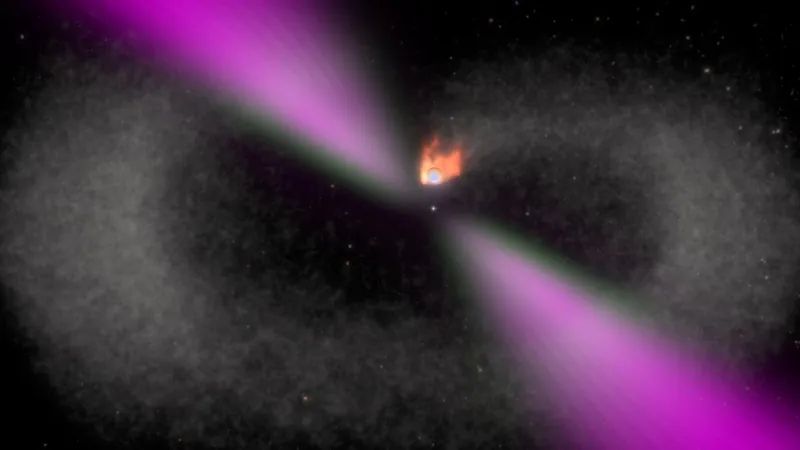
Groundbreaking Discovery: JWST Unveils Carbon-Laden Exoplanet in a Pulsar System
2025-09-11
Author: Nur
A Discovery That Could Change Everything
Science thrives on surprises that challenge our understanding of the cosmos. Recently, researchers utilizing the James Webb Space Telescope (JWST) stumbled upon something extraordinary: an exoplanet orbiting a pulsar with an atmosphere almost entirely composed of carbon.
Meet PSR J2322-2650: The Pulsar That Steals
The pulsar in question, PSR J2322-2650, is often termed a 'black widow' system because it drains material from its neighboring star. This process typically leads to the formation of a 'hot Jupiter'—a gas giant that orbits dangerously close to its parent neutron star. In this case, the exoplanet, designated PSR J2322-2650b, orbits its pulsar every 7.8 hours and appears to be the result of the star's high-energy bombarding effects.
An Atmosphere Like No Other
What sets PSR J2322-2650b apart is not just its size but its astonishing atmosphere. While it shares characteristics typical of a massive gas giant, it features a hauntingly unique atmospheric composition: elemental carbon, primarily in the forms of tricarbon (C3) and dicarbon (C2). Such elements are usually observed in comet tails or flames on Earth, making their prevalence in this exoplanet's atmosphere a groundbreaking revelation.
Day and Night: A Tale of Extremes
This planet exhibits extreme temperature variations. The sunlit side, perpetually facing the pulsar, can soar above 2000 °C, showing distinct chemical signatures. Contrastingly, the night side lacks features, hinting at a shrouded surface possibly coated in soot.
Carbon Ratios That Defy Explanation
For added intrigue, researchers discovered staggering ratios of carbon to oxygen and nitrogen in the atmosphere: a C/O ratio exceeding 100 and a C/N ratio above 10,000. To put that in perspective, Earth's C/O and C/N ratios are a mere 0.01 and 40, respectively. This raises eyebrows about how a carbon-rich atmosphere could survive, especially considering what we know about the black widow formation process.
Rethinking Planetary Formation
The persistence of an atmosphere loaded with carbon contradicts the traditional models of exoplanet formation. Science posits that the intense radiation from the pulsar should have stripped away those outer layers, yet this planet defies those expectations. Compounded by theories like white-dwarf mergers, the exact origin of such a carbon-heavy environment remains enigmatic.
A Puzzle Worth Solving
Despite its contradictions, PSR J2322-2650b still aligns with some aspects of existing theories. Models suggest that rapidly spinning planets would create powerful westerly winds, differing from the commonly observed easterly winds on similar planets. Interestingly, JWST data reveal the hottest zone on this planet is about 12 degrees west of the expected center, offering groundbreaking observational support for this phenomenon.
The Next Scientific Revolution?
In essence, PSR J2322-2650b stands at the crossroads of understanding and mystery. While it matches the size and rotation for a black widow pulsar system, its baffling atmosphere invites scientists to revisit current theories. As JWST continues its quest, who knows what more astonishing discoveries await in the cosmos?





 Brasil (PT)
Brasil (PT)
 Canada (EN)
Canada (EN)
 Chile (ES)
Chile (ES)
 Česko (CS)
Česko (CS)
 대한민국 (KO)
대한민국 (KO)
 España (ES)
España (ES)
 France (FR)
France (FR)
 Hong Kong (EN)
Hong Kong (EN)
 Italia (IT)
Italia (IT)
 日本 (JA)
日本 (JA)
 Magyarország (HU)
Magyarország (HU)
 Norge (NO)
Norge (NO)
 Polska (PL)
Polska (PL)
 Schweiz (DE)
Schweiz (DE)
 Singapore (EN)
Singapore (EN)
 Sverige (SV)
Sverige (SV)
 Suomi (FI)
Suomi (FI)
 Türkiye (TR)
Türkiye (TR)
 الإمارات العربية المتحدة (AR)
الإمارات العربية المتحدة (AR)